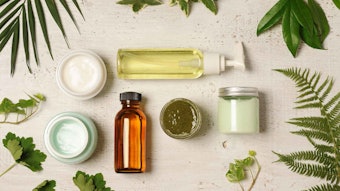From the column editor: Scientists are finding that particles so tiny they are barely there—nanoparticles, which have found homes in electronics, food containers, sunscreens and a variety of other applications—can breech our most personal protective barrier, the skin. Nanotechnology is a broad term, covering the building of structures and machines on an atomic or molecular scale-in the range of 1 to 100 nanometers (nm). The big issue is the behavior of substances at the nano-scale level. A substance at 500 nm can have drastically different properties than the same substance at 10 nm. The emerging field of nanotechnology involves scientists from many different disciplines, including physicists, chemists, engineers and biologists. In recent years, nanotechnology has found beneficial use in medicine, electronics, clinical laboratory analysis, imaging and therapeutics.
This month, I welcome Julian Hewitt, technical specialist for Croda Suncare & Biopolymers, to present an overview of nanotechnology with a focus on sun care. Hewitt graduated from Oxford University in 1988 with a degree in chemistry after which he joined Tioxide, working on new product development. In 1991, he joined Tioxide's Solaveil Business as the applications research and technical service manager for physical sunscreen products. He has remained with the Solaveil business as it moved to ICI Performance Chemicals, Uniqema, and finally Croda. Hewitt has presented papers and posters at more than 30 conferences and has written or co-authored more than 20 articles and four book chapters on formulating sunscreens and in vitro SPF testing.
What is Nanotechnology?
There is much excitement, and controversy, in the world these days regarding nanotechnology. Advocates point to the seemingly limitless array of applications and advantages of nano-scale materials, while at the opposite end of the spectrum, there are those who fear the headlong rush into a frightening new field without properly evaluating potential risks to human health and the environment.
Products that use or claim to use nanotechnology are emerging in many different markets. The Nanotechnology Consumer Products Inventory,1 an online database from the Project on Emerging Nanotechnologies, lists more than 600 consumer products in categories as diverse as electronics, toys, household appliances, clothing, cleaning products, pet care, food and personal care.
So what exactly is nanotechnology and what are its applications in cosmetics and personal care? Nanotechnology is one of those terms that most think they understand—in the scientific community, at least—but for which most would struggle to provide a precise definition. This may be because there is no official, globally recognized definition of the term; it is, however, generally accepted that nano-scale substances are smaller than 100 nm. This is where the physical and/or chemical properties of the material are significantly different than the larger size or bulk versions of the same material. A current draft definition from the German Standards Institute (DIN) and the International Standards Organization defines the following:
- Nano-object: An object having one or more dimensions (i.e., length, width or thickness) on the nano-scale;
- Nanoparticle: An object having three external dimensions on the nano-scale;
- Nanorod: An object having two external dimensions on the nano-scale; and
- Nanoplate: An object having one external dimension on the nano-scale.
Here, nano-scale is being defined as approximately 1–100 nm.
It also is important to recognize that some materials can exist as particles that have an external size greater than the nano-scale but that consist of aggregates or agglomerates of smaller particles or crystals that are within the nano-scale range. The DIN/ISO proposal describes these as nano-structured aggregates or nano-structured agglomerates. The terms aggregate and agglomerate are often confused or used interchangeably but they are in fact quite distinct and are defined as follows:2
- Aggregate: A particle comprising strongly bonded or fused particles wherein the resulting external surface area may be significantly smaller than the sum of calculated surface areas of the individual components.
- Agglomerate: A collection of loosely bound particles or aggregates or mixtures of the two wherein the resulting external surface area is similar to the sum of the surface areas of the individual components.
Applications in Personal Care
Many modern cosmetic products contain nano-sized components. Examples include the following.
Nanoemulsions: These emulsions typically have a droplet size of 50–100 nm that, due to this size, are usually transparent or at least translucent in appearance. Nanoemulsions also provide pleasant texture and/or skin feel.
Liposomes, niosomes, nanosomes and nanocapsules: Liposomes and niosomes are globular vesicles that can vary from 25 nm to 5000 nm in size and are used to encapsulate active ingredients in order to improve their stability or skin delivery (and thus efficacy). Nanocapsules represent a similar concept except that they have rigid walls.
Fullerenes: A number of prestige cosmetic products have been developed that contain C60 fullerene molecules, which have unique antioxidant properties.
Inorganic sunscreens: Perhaps the most common types of nanoparticles in personal care are the UV-attenuating grades of titanium dioxide and zinc oxide. A small particle size is required with these materials to provide effective UV protection in addition to transparency on the skin.
Other inorganic particles: Nano-scale forms of, for example, iron oxide, silica and alumina, also have found application in cosmetic products as colors, fillers or rheological additives.
Of these nano-sized materials, nanoemulsions and vesicles are designed to break down into their constituent ingredients when applied to skin or hair. Thus, in terms of assessing risk, these materials act the same as conventional cosmetic emulsions and delivery systems. Assessing the safety of such systems is then simply a matter of considering the safety of the bulk constituents; the fact that they are in a nano-form in the formulation is irrelevant. For this reason, the primary focus of safety and regulatory agencies has been toward nanomaterials that remain as nano-objects when applied to skin or hair. Summarizing this, the International Cooperation on Cosmetic Regulation (ICCR) has proposed the definition of a cosmetic nanomaterial to be: a stable, insoluble material, purposely manufactured, where the primary particle has at least two dimensions on the order of 1 to 100 nm.
The most commonly used type of cosmetic nanomaterials are inorganic sunscreens and hence these have become the focus of much current debate in regard to nanotechnology in personal care. One aspect of that debate is whether these materials are, in fact, nanomaterials, so this must first be examined.
Efficacy and Particle Size of Inorganic Sunscreens
The optical properties of inorganic oxides of various particle sizes can be calculated by the use of Mie theory,3 a generally well-known theory related to inorganic oxides used as pigments or sunscreens that explains how the optical properties of scattering and absorption vary with particle size and refractive index. Applying this theory to titanium dioxide4 will result with the conclusion that a particle size of less than 100 nm is necessary to achieve effective UV protection while maintaining cosmetic elegance; i. e., the product is transparent in a thin film. The optimum size is calculated to be around 50 nm. Many grades of fine particle TiO2 are available today from various sources and most show good efficacy as sunscreens; however, particle sizes are claimed to range anywhere from 10 nm to well above 100 nm—contradicting the theoretical calculations. The answer to this paradox lies in the confusion arising from different definitions for particle size and the variation in results given by different particle techniques.
Fine-particle TiO2 is manufactured as nanoparticles that are typically 10--20 nm in size, and some suppliers promote this as the particle size. However, this is somewhat misleading because these nanoparticles form tightly bound aggregates (see above definition), which obviously have a somewhat larger size. These aggregates are the smallest particles actually present in the system and the forces required to break apart the aggregates are far greater than those encountered during manufacturing or application of these products onto skin.
The story does not end there. These aggregates join together to form loosely bound agglomerates. In the dry, powdered form of inorganic sunscreen in which these materials are supplied, the agglomerates have particle sizes greater than 1 micron, placing them well outside the nano-scale range. Yet the Mie Theory states that these agglomerates must be broken down to some degree in the final formulations because such large particles would not be effective as sunscreens and would look white and opaque on skin. The as-yet unanswered question is to what degree the agglomerates break down, and what the particle size is in the final formulation. This is difficult to determine in emulsions because the results from many particle sizing techniques are confounded by the size of the emulsion droplets, making it difficult to distinguish the size of other particles, such as inorganic sunscreens.
The situation is not helped by the plethora of particle-sizing techniques available and the different results given by these methods. Some techniques measure the component nanoparticles while others measure the size of aggregates and/or agglomerates. Also, any measurement is dependent upon how the samples are prepared. This is why the particle sizes quoted by manufacturers can vary so widely; in order to compare different grades, it is necessary to measure them by the same technique and with the samples prepared in the same way.
Safety of Inorganic Sunscreens
This nanomaterials debate seems to be getting sidetracked by arguments over the "true" particle size of inorganic sunscreens and whether or not they really are nanomaterials. The key question remains: Are they safe? Based on the large body of evidence the exists, the answer has to be an overwhelming, "Yes!"
Much of the concern around nanotechnology has been based on the premise that nanomaterials are so new that they have not been properly tested to ensure safety. This may be true of some nanomaterials but it is important to recognize the distinction between inorganic sunscreens and other types of nanoparticles.
Trying to treat all nanomaterials as though they pose the same degree of risk is not a reasonable approach. Fine particle grades of TiO2 and ZnO have been used in cosmetic products for nearly 20 years and have been subjected to extensive safety testing, the results of which have been independently reviewed by regulatory bodies and other organizations. A comprehensive review of the safety studies on these materials was published in 2007.5 The current listing of TiO2 as a UV filter on Annex VII of the EU Cosmetics Directive is based on an extensive dossier on the various aspects of consumer safety with TiO2, submitted by the industry and carefully evaluated by the SCCNFP (predecessor of SCCP). The opinion adopted by the SCCNFP in October 2000 is publicly available.6
It has been speculated that nanoparticles in cosmetics may penetrate through the skin. This aspect has been the subject of many studies and the evidence shows that insoluble nanoparticles, such as those used in inorganic sunscreens, do not penetrate into or through human skin. Further, the industry submitted a review of recent literature on safety of nanomaterials in cosmetics, with special references to skin absorption and resorption of ultrafine TiO2, to SCCP in 2005. Several new studies further indicate that ultrafine TiO2 does not penetrate the skin. This lack of penetration into or through human skin by UV attenuation forms of TiO2 used in sunscreens, as well as the absence of any health risk, has been acknowledged by the German7 and Australian8 health authorities.
Conclusion
A variety of different types of nanomaterials are being used in personal care products. Speculation around the penetration of these materials through skin, and possible implications for human health, have resulted in the call for increased regulations on such products. However, each different type of nanomaterial should be considered on a case-by-case basis. The type that has received the most attention is that of inorganic sunscreens, with which there has been ongoing debate as to whether these materials really should be considered nanomaterials at all. Regardless, a large body of evidence is available that shows that inorganic sunscreens do not penetrate skin and are completely safe for topical use.
Acknowledgements: The author would like to thank his colleagues, Laurie Hughes, Lorna Kessell, Carole Tapley and Ian Tooley, for their invaluable contributions to this article.
References
Send e-mail to [email protected].
1. The Project on Emerging Nanotechnologies, Woodrow Wilson International Center for Scholars Web site, available at: www.nanotechproject.org/inventories/consumer/ (Accessed Oct 1, 2008)
2. Publically Available Specification Terminology for Nanomaterials PAS 136:2007, The British Standards Institution Web site, available at: www.bsigroup.com/upload/
standards%20&%20Publications/Nanotechnologies/PAS%20136.pdf (Accessed Oct 1, 2008)
3. G Mie, Phys. Lpz., 25:377 (1908)
4. JL Robb, LA Simpson and DF Tunstall, DCI magazine (Mar 1994)
5. GJ Nohynek, J Lademann, C Ribaud and MS Roberts, Grey goo on the skin? Critical Reviews in Toxicology, 37 251-277 (2007)
6. Opinion of the Scientific Committee on Cosmetic Products and Nonfood Products Intended for Consumers Concerning Titanium Dioxide Colipa S75, European Commission Web site, available at: europa.eu.int/comm/health/ph_risk/
committees/sccp/documents/out135_en.pdf (Accessed Oct 1, 2008)
7. Federal Institute for Risk Assessment (BfR) Web site, available at: www.bfr.bund.de (Accessed Oct 1, 2008)
8. Safety of sunscreens containing nanoparticles of zinc oxide or titanium dioxide, Australian Government Department of Health and Aging, Therapeutic Goods Administration (TGA) Web site, available at: www.tga.gov.au/npmeds/sunscreen-zotd.htm (Accessed Oct 1, 2008)










